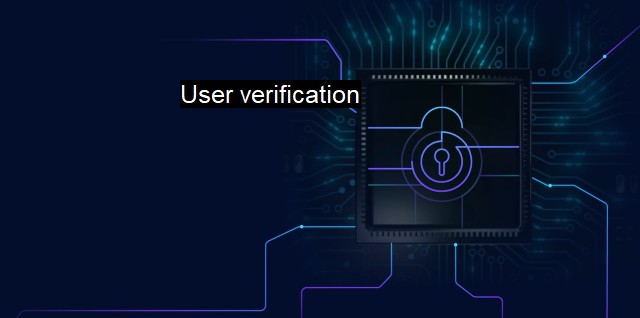What is User verification?
Enhancing Cybersecurity with User Verification: Exploring the Role of Multi-Factor Authentication in Safeguarding Networks and Information
User verification, in the landscape of cybersecurity and antivirus software, is a critical process that relies on authenticating the identity of a user. The goal is to ensure only authorized individuals have access to specific data, accounts, or systems. It is a key process in keeping robust cybersecurity structures as it significantly helps in mitigating potential online threats, including hacking, phishing, among others.There's a substantial relevance of user verification in the internet realm—notably, within online banking services, corporate intranets, social networking sites, antivirus software, cybersecurity systems, and few other applications where user identification is crucial. Importantly, the process employs approaches and mechanisms that can verify whether the user is who they claim to be or not.
The first level of user verification typically involves usage of login credentials - a unique username and secure password. These are created by the user and must be kept confidential. They help in deterring unauthorized users from accessing information that does not belong to them. Robust practices must be in place, but threats like brute force attacks, wherein multiple combinations of passwords are attempted until access is gained, show that relying solely on basic login details is often not enough.
For an enhanced layer of security, two-factor authentication (2FA) or multi-factor authentication (MFA) is used. These require one or more additional steps after entering login credentials, confirming that the verified user is indeed the account holder. Mere possession of login credentials is insufficient in these verification methods. The additional steps may involve physical tokens, biometric data, or one-time PINs. These not only create an extra layer of difficulty for unauthorized users attempting access but also provide an alarm if someone enters the correct first-step credentials.
Another sophisticated approach toward user verification is knowledge-based authentication prompts. This often includes security questions to which only the verified user knows the answer. Personal identification, like fingerprints, voice recognition, and facial recognition, are also quite common these days and are called biometric verifications, thanks to advancing technology.
User verification also presents itself as crucial in antivirus software. Effective antivirus software requires the user to register the product, thus validating their purchase and ownership. Verification via providing a license key or creating a unique login is a standard process. Further, regular updates to the software may also need re-verification to ensure only a verified user is making alterations.
While user verification fills in a significant span of the cybersecurity front, it is not an entire solution. It has its limitations and challenges too. For instance, users may forget their passwords or security answers, lose their hardware tokens, etc., causing delay and distress in accessing the required systems. Another downside is that some users may find the additional steps annoying and tedious, especially for seemingly low-risk systems. From the side of implementation, collecting, storing, and properly securing a large amount of authentication data is often burdensome and possibly risky for system authorities.
Thus, user verification in cybersecurity and antivirus ought to strike a balance between security, functionality, and usability. While more robust and layered verification systems provide better security, they should also be congruent with system purpose and user convenience. After all, user verification is a part of the effort to create a barrier between cyber threats and digital assets. It is not the perfect, foolproof answer to cybersecurity, but is indeed a significant facets of safeguards and preventive measures formed to steer clear of potential cybersecurity breaches. In an increasingly digital world, understanding and leveraging user verification is a cybersecurity necessity.

User verification FAQs
What is user verification?
User verification is the process of confirming the identity of a user or device, typically through the use of authentication methods such as passwords, biometrics, or security tokens. It is an essential component of cybersecurity and antivirus systems to ensure that only authorized individuals or devices are granted access to sensitive information or resources.Why is user verification important in cybersecurity and antivirus?
User verification is critical in cybersecurity and antivirus because it helps prevent unauthorized access to sensitive information or resources, which can result in data breaches and cyber attacks. By verifying the identity of users or devices, organizations can ensure that only authorized individuals or devices are granted access, minimizing the risk of security breaches and protecting against potential threats.What are some common methods of user verification in cybersecurity and antivirus?
Some common methods of user verification include passwords, biometrics such as fingerprint or facial recognition, security tokens such as smart cards or USB keys, and two-factor or multi-factor authentication. These methods help ensure that users and devices are who they claim to be and provide an additional layer of security against potential threats.What are some best practices for user verification in cybersecurity and antivirus?
Some best practices for user verification in cybersecurity and antivirus include using strong passwords or passphrases, implementing two-factor or multi-factor authentication, regularly updating security software and firmware, using encryption to protect sensitive data, and auditing user activity to detect anomalies or potential security breaches. These best practices help ensure that cybersecurity and antivirus systems remain effective and up-to-date in protecting against potential threats.| | A | | | B | | | C | | | D | | | E | | | F | | | G | | | H | | | I | | | J | | | K | | | L | | | M | |
| | N | | | O | | | P | | | Q | | | R | | | S | | | T | | | U | | | V | | | W | | | X | | | Y | | | Z | |
| | 1 | | | 2 | | | 3 | | | 4 | | | 7 | | | 8 | | |||||||